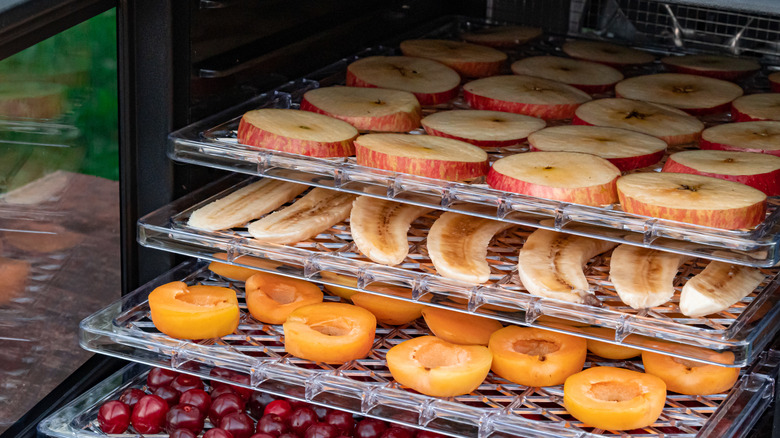Is It Possible To Make Dehydrated Avocado?
Avocados make any recipe more delicious. While it's not actually a vegetable nor is it a fruit, it does have nutty nuances and a delicate grassiness that can add layers of flavor, as well as a creamy texture (via California Avocados). The leathery-skinned avocado is available year-round in the supermarket, but a deliciously ripe, in-season avocado, might have you wondering whether or not there's a way to extend the berry's shelf life. Freezing is one option, and pickling is another, but what about dehydrating avocados?
One of the oldest preservation methods, ScienceDirect explains that food dehydration is a process that reduces a food's moisture level through evaporation, usually triggered by a heat source. As a result, produce or protein that's stripped of its bacteria-creating moisture can be kept at room temperature without the risk of spoiling. Naturally, dehydrating is a no-brainer for those looking to preserve seasonal flavors, pack nutritious fare for a journey on foot, or even prepare for emergency situations. However, the method does have its drawbacks.
In addition to having a higher content of calories by weight, LiveStrong shares that depending on the food, sodium and sugar levels may be increased per serving. Not to mention that preparing foods to dry can be time-consuming. Plus, not all foods hold up quite as well once they're dehydrated. So, where does that leave the humble avocado?
Avocados can be dehydrated, but here's what to consider
In theory, basically, everything can be dehydrated. But, just because it can be dehydrated, that doesn't mean it always should be. According to REI, since fats don't fully evaporate, they're more apt to go rancid. This is why Fresh Off the Grid shares that a high-fat avocado isn't the most ideal food to dehydrate — it'll dry, but only to a still-sticky, leathery stage.
However, if you intend to use dehydrated avocado in a timely manner, then rev up the dehydrator. After marinating thin slices of avocado in citrus juice, Avocados from Mexico recommends laying pieces on the dehydrator sheet and drying anywhere between eight to 10 hours at a temperature of about 135 degrees Fahrenheit. Once the avocado slices have shrunk approximately half of their size, they can be removed and stored in an airtight container.
Don't have a dehydrator? That's not a problem. Of the many alternatives such as sun drying or freeze-drying, Mishry also suggests dehydrating pieces of avocado by using an appliance like the microwave or the oven, the latter functioning most like a proper dehydrator. In just a few short hours, avocados will be moisture-free and ready to be enjoyed at a later date.

